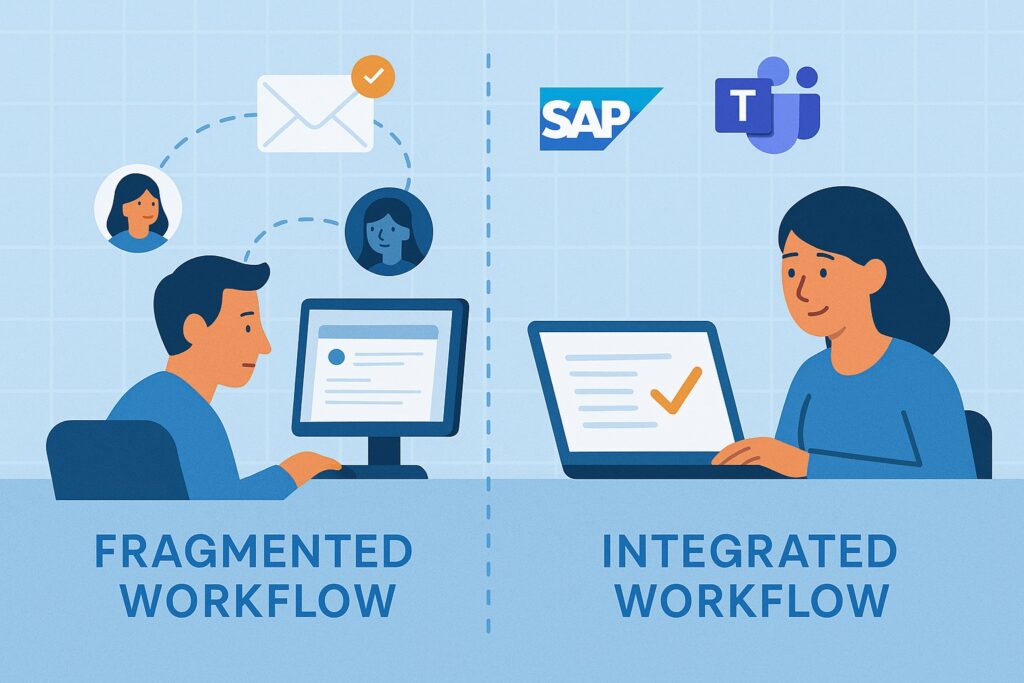The 89% Decision Speed Gap: Why Your Competitors Are Pulling Ahead
The 89% Decision Speed Gap: Why Your Competitors Are Pulling Ahead
While your organization routes purchase order approvals through email chains taking 18.6 hours average completion time, your competitors with integrated Teams workflows complete identical decisions in 2.1 hours. That's an 89% decision speed advantage that compounds with every delayed approval, every missed opportunity, and every frustrated stakeholder.
This isn't just operational efficiency—it's systematic competitive disadvantage that accumulates daily. In markets where response speed determines success, organizations with fragmented SAP workflows find themselves consistently outmanoeuvred by competitors who have eliminated the friction between business decisions and execution.
The Velocity Imperative
Modern business operates at unprecedented speed. Customer expectations, supplier relationships, market opportunities, and competitive pressures all demand rapid decision-making and immediate execution. Yet most SAP organizations continue operating approval processes designed for slower business eras when decisions could wait for office hours, desktop access, and sequential email coordination.
Research from Great Place to Work reveals that 97% of Fortune 100 Best Companies to Work For support Teams-based workflows as the foundation of modern work. These organizations consistently outperform peers in productivity, employee satisfaction, and business results—not coincidentally, but because streamlined decision-making creates cumulative competitive advantages.
The early adopter window for workflow integration is narrowing rapidly. Organizations implementing now gain first-mover advantages, while those waiting face increasing penalties as industry standards evolve toward integrated collaboration environments.
Measuring the Decision Speed Gap
The 89% decision speed difference between fragmented and integrated workflows isn't theoretical—it's measurable across multiple process categories and organizational contexts.

Simple Approval Processes
Routine Purchase Orders: Standard procurement requests under established thresholds
- Fragmented Workflow: 18.6 hours average approval time
- Integrated Workflow: 2.1 hours average approval time
- Speed Advantage: 89% faster completion
Expense Report Approvals: Employee reimbursement and travel expense processing
- Fragmented Workflow: 2.3 days average approval time
- Integrated Workflow: 4.2 hours average approval time
- Speed Advantage: 82% faster completion
Budget Allocation Requests: Departmental spending authorization and resource allocation
- Fragmented Workflow: 1.8 days average approval time
- Integrated Workflow: 3.6 hours average approval time
- Speed Advantage: 84% faster completion
Complex Decision Processes
Multi-Stakeholder Approvals: Procurement decisions requiring input from multiple departments
- Fragmented Workflow: 4.7 days average completion
- Integrated Workflow: 1.2 days average completion
- Speed Advantage: 74% faster decision-making
Exception Handling: Non-standard requests requiring special authorization
- Fragmented Workflow: 6.2 days average resolution
- Integrated Workflow: 1.8 days average resolution
- Speed Advantage: 71% faster exception processing
Strategic Investment Decisions: Capital expenditure and technology investment approvals
- Fragmented Workflow: 12.4 days average approval cycle
- Integrated Workflow: 4.1 days average approval cycle
- Speed Advantage: 67% faster strategic decisions
Emergency Response Capability
Urgent Supplier Payments: Critical payment authorizations to maintain supplier relationships
- Fragmented Workflow: Delayed until business hours, VPN access available
- Integrated Workflow: Real-time approval capability through mobile Teams
- Speed Advantage: 24/7 business continuity vs. office-hour limitations
Crisis Decision-Making: Rapid response to operational emergencies and market changes
- Fragmented Workflow: Phone tag, email coordination, manual stakeholder assembly
- Integrated Workflow: Instant team collaboration with full context and decision authority
- Speed Advantage: Minutes vs. hours for crisis response coordination
The Competitive Disadvantage Cascade
Decision speed gaps create cascading competitive disadvantages that extend far beyond individual approval delays:
Market Opportunity Response
Competitive Tenders: Time-sensitive proposals requiring rapid resource allocation and executive approval
- Your Response: 3-day internal approval process before proposal submission
- Competitor Response: Same-day approval and immediate proposal development
- Result: Competitor submits compelling proposal while you're still seeking internal authorization
Supplier Negotiations: Limited-time pricing opportunities and partnership agreements
- Your Response: Email coordination to assemble stakeholder input and approval authority
- Competitor Response: Real-time collaboration enabling immediate negotiation and decision-making
- Result: Competitor secures favourable terms while you coordinate internal processes
Strategic Partnerships: Time-sensitive collaboration opportunities with key industry players
- Your Response: Multi-day approval chain involving legal, finance, and executive review
- Competitor Response: Integrated workflow enabling rapid due diligence and decision authority
- Result: Competitor establishes market-advantageous partnerships while you deliberate
Customer Relationship Impact
Project Delivery Commitments: Client expectations for rapid resource allocation and project initiation
- Your Capability: Days required for internal approval before client commitment
- Competitor Capability: Real-time resource allocation enabling immediate client engagement
- Result: Clients choose competitors who can match their velocity expectations
Service Response Times: Customer support and issue resolution requiring internal coordination
- Your Process: Email escalation and approval chains for complex customer solutions
- Competitor Process: Instant collaboration enabling immediate customer response authority
- Result: Customer satisfaction advantage for competitors with streamlined internal processes
Revenue Recognition Speed: Financial close procedures and revenue reporting affecting investor relationships
- Your Timeline: Extended month-end close due to approval coordination delays
- Competitor Timeline: Streamlined close procedures through integrated workflow automation
- Result: Competitive advantage in investor communications and market positioning
Innovation and Agility Penalties
Product Development Speed: Innovation projects requiring rapid resource allocation and cross-functional coordination
- Your Capability: Approval delays slow innovation cycles and time-to-market
- Competitor Capability: Integrated workflows accelerate innovation and competitive response
- Result: Market leadership advantage for competitors with faster innovation execution
Strategic Initiative Implementation: Organizational change and improvement programs requiring coordinated execution
- Your Execution: Email-based coordination slows strategic initiative implementation
- Competitor Execution: Teams-based collaboration accelerates strategic execution and results realization
- Result: Cumulative strategic advantage for competitors with superior execution capability
The Network Effect of Speed Advantage
Decision speed advantages create network effects that amplify competitive positioning over time:
Supplier Preference Development
Suppliers prioritize partners who can make quick decisions and process approvals efficiently. Organizations with streamlined workflows become preferred partners for:
- Volume Discounts: Suppliers offer better pricing to partners who can commit quickly
- Innovation Partnerships: Technology providers collaborate with organizations that can rapidly evaluate and implement solutions
- Supply Chain Priority: During capacity constraints, suppliers prioritize customers with efficient approval processes
Customer Loyalty Acceleration
Clients increasingly expect internal business velocity that matches market pace. Organizations with integrated workflows develop competitive advantages through:
- Response Time Leadership: Faster internal processes enable superior customer responsiveness
- Project Delivery Speed: Streamlined resource allocation accelerates client project execution
- Relationship Depth: Efficient internal coordination enables deeper customer partnership development
Talent Attraction Differential
Modern professionals expect efficient work environments that maximize productive time. Organizations with fragmented workflows face:
- Recruitment Challenges: Top talent chooses employers with streamlined, efficient work processes
- Retention Risk: Frustrated employees leave for organizations with better workflow integration
- Productivity Gaps: Lower-performing team members struggle more with fragmented processes
The Technical Infrastructure of Speed
Achieving sustainable decision speed advantages requires technical infrastructure that supports real-time collaboration and mobile-first business processes:
Mobile-Enabled Decision Authority
Anywhere Access: Business decisions happen regardless of location or device availability
Real-Time Notifications: Critical approvals receive immediate attention through intelligent notification systems
Contextual Information: Decision-makers access complete business context without application switching
Collaborative Input: Multi-stakeholder decisions happen through real-time collaboration rather than sequential email coordination
Process Visibility and Coordination
Workflow Transparency: All stakeholders understand approval status and requirements without manual coordination
Bottleneck Identification: Process delays become visible immediately, enabling rapid intervention
Escalation Automation: Approval delays trigger automatic escalation to maintain business velocity
Audit Trail Automation: Decision documentation happens automatically without administrative overhead
Integration Architecture Advantages
Platforms like Looply enable sustainable speed advantages through:
Pre-Built SAP Connectivity: Proven integration eliminates custom development timelines and risk
Native Teams Integration: Full mobile functionality with enterprise security and compliance
Rapid Implementation: 6-9 week deployment enables immediate competitive advantage realization
Scalable Architecture: Solution grows with organizational needs without performance degradation

The Strategic Choice Framework
Organizations face a strategic choice that determines competitive positioning for years:
Option 1: Lead Through Integration
- Immediate Benefits: 89% decision speed advantage, improved employee satisfaction, enhanced customer responsiveness
- Competitive Positioning: First-mover advantage in operational excellence and market responsiveness
- Long-Term Value: Cumulative competitive advantages through superior execution capability
- Investment Timeline: 6-9 weeks to competitive advantage realization
Option 2: Follow with Delayed Implementation
- Short-Term Reality: Continue accepting 89% speed disadvantage while competitors gain market position
- Catch-Up Challenges: Later implementation faces higher user expectations and competitive pressure
- Market Position: Playing defence while competitors accelerate market advantages
- Investment Timeline: Delayed benefits with higher competitive pressure
Option 3: Maintain Status Quo
- Immediate Consequences: Daily productivity losses of £4,398 with compounding competitive disadvantage
- Strategic Risk: Systematic market position erosion as competitors implement workflow advantages
- Talent Impact: Employee frustration and retention challenges in competitive labour markets
- Long-Term Viability: Questionable sustainability as industry standards evolve toward integrated workflows
The Urgency of Implementation
The window for competitive advantage through workflow integration is narrowing as adoption accelerates across industries. Organizations planning now secure:
- Implementation Calendar Priority: Early engagement ensures optimal deployment timing
- Change Management Advantage: Implementation before industry-wide adoption enables easier user adoption
- Competitive Positioning: First-mover advantages in market responsiveness and operational excellence
- Cost Optimization: Early implementation avoids premium pricing as demand for integration services increases
The evidence is overwhelming: organizations with integrated SAP-Teams workflows operate at fundamental speed advantages that compound into sustainable competitive positioning. The question isn't whether decision speed matters—it's whether your organization will lead with workflow innovation or follow with productivity disadvantages.
Ready to assess your decision speed gap and explore integration opportunities?
Download the Complete Competitive Analysis: "The Hidden Productivity Crisis in SAP Organizations"
This comprehensive white paper provides detailed speed benchmarking frameworks, competitive positioning analysis, and implementation roadmaps for achieving decision speed advantages.




